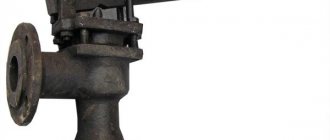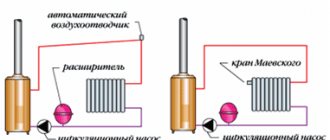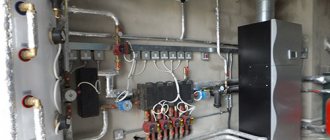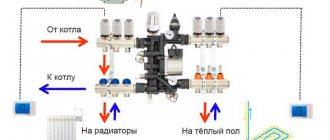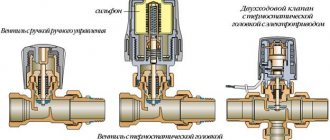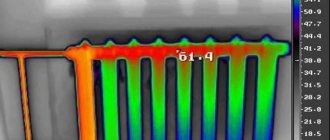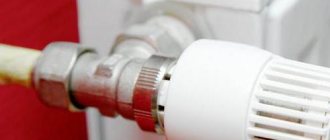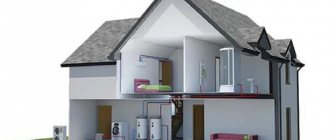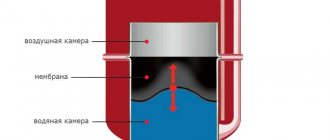Make-up units for different types of heating systems
Open system
- expansion tank;
- boiler (its choice depends on the power and type of fuel);
- radiators;
- pipes for laying a solid pipeline;
- shut-off valves made of stainless steel.
Due to the natural circulation of the coolant, pipes in an open system warm up slowly, but the water in them does not boil, which means it does not harm the walls of the pipeline. If the heating is not used in winter, the water must be drained from it.
- The boiler is located on the lower pipeline.
- The expansion tank is installed above the boiler at the top of the circuit. In winter it must be insulated.
- The pipes are connected to each other, but there should be few of these connections, as well as pipeline turns, in an open system.
- The tap and filter device are installed in those circuits where the coolant is filled into the system manually.
Closed system
- Expansion tank
, which regulates the water level, maintaining it within established limits. Using it, the coolant flow is controlled. The tank body is made of durable metal, which consists of two parts, they are separated from each other by a rubber diaphragm. When heated and expanded, the liquid flows into the expansion tank behind the membrane, and after the liquid cools, the gases released and accumulated behind the membrane push the liquid out of the tank out. - Pressure reducing valve with filters
. Its design differs from its open system counterpart in that it is equipped with pressure gauges that monitor pressure levels. To choose the right device, it is worth calculating the system loads in advance. The valve has a special membrane that is subject to pressure generated by the pump. Its design includes a spring, which, after tension, creates a certain pressure necessary to displace the liquid. Thanks to this device, the closed system works quickly and safely. - Filter
. It will protect the system from debris getting into it and scale formation on the walls of the pipeline. - Check valve
. It is installed directly behind the pressure relief valve and prevents dirty water from entering the pipeline. It can be used separately or integrated into the make-up valve. - Flow breaker
. It is mounted in front of the pressure reducing valve; structurally, it consists of a drain pipe, at the ends of which check valves are located.
In any system, it is necessary to maintain a constant volume of coolant liquid in order to prevent an emergency.
Main elements of the automatic replenishment unit
You can, of course, make up for coolant losses in the heating system of a private home manually. However, in large suburban residential buildings, such a procedure can be quite tedious and technologically complex. Therefore, in such houses, special units are most often installed that automatically supply water to the heating network circuit when the pressure drops in it. The design elements of such devices are:
- pressure reducing valve;
- check valve;
- water purification filters.
Signs of lack of coolant
Water in the heating system circuit can decrease for various reasons. And this happens quite often. If the owners of the house have not yet bothered to install an automatic system for replenishing the heating network, you can determine the lack of coolant by the following signs:
- overheating of the supply water supply and cold radiators;
- gurgling water in the riser;
- frequent starts and stops of the gas boiler burner;
- overheating of the solid fuel boiler and activation of the safety valve.
A shortage of coolant in the circuit is especially dangerous if a TT boiler is used as the main heating equipment in the network. If there is not enough water in such a unit, it will boil. After its complete evaporation, a fire will definitely start in the boiler room. Unfortunately, such situations are far from uncommon.
Also, due to a lack of coolant in the heating system, pipes may melt, radiators may fail, etc. Therefore, it is imperative to monitor the pressure in the circuits of heating systems set for private houses (1.5-2 bar).
Loss of coolant: reasons
The amount of water in the heating system circuit of a private home may decrease for the following reasons:
- As a result of leaks. Water can flow out of the circuit at the joints of pipes when they are depressurized.
- When the pressure in the system critically increases and the emergency valve is activated. In this case, part of the coolant is simply discharged from the pipes.
- In open systems - due to evaporation from the expansion tank. Nowadays, such elements of the heating system are not completely open. Their design simply provides for contact with the atmosphere. But still, in tanks of this type, water evaporation is usually quite intense.
- Due to the activation of air vents. When removing accumulated air bubbles from the circuit, for example, through Mayevsky taps, part of the coolant also comes out (in the form of steam).
- Through coarse filters. Such devices require periodic washing. During this procedure, some of the coolant may be lost from the circuit.
Closed heating system
After filling, the remaining air is released through the Mayevsky tap.
In systems of this type, the liquid does not interact with air outside the heating circuit; it circulates due to the pump. The design includes an expansion tank with a membrane. It is a sealed container that is divided into two parts using a rubber partition. The lower compartment contains the coolant, and the upper compartment contains air under constant pressure of 1.5 atmospheres.
It is better to do the work of pouring water together. One person monitors the release of air from the pipes, and the other adds coolant. If it is not possible to work together, the liquid is poured gradually under low pressure.
Algorithm for pouring water into the heating system in a private house with a closed type:
- Opening the valve and placing a container under it to drain the water. Remaining liquid will fill the tank, after which it must be drained.
- The pipe has a slight slope to the bottom. A tap is installed in this place, thanks to which excess water is removed. There is also a pipe with a check valve for filling the coolant. If a water pipe is connected to it, you should open the tap. Otherwise, the liquid is added using a hose. The pressure should be slightly higher than in the heating system.
- The taps are closed when the pipes and radiators are completely filled with coolant. The water shuts off when the pressure on the pressure gauge reaches 1.5 atmospheres. The value may be different; it can be found in the device data sheet.
- Bleeding air through the Mayevsky tap.
Tap for pumping water into a double-circuit boiler - the system is filled automatically.
Double-circuit boilers are also installed in houses. They contain a faucet for pumping water, so there will be no problems with the supply of coolant. The user just needs to open the tap at the bottom of the housing. The heating system of the house will be filled through it. To remove residual air, a valve is placed at the top. Moreover, many models have an automated air mass discharge system.
If an AOGV gas boiler is installed in the house, in order to fill a closed-type heating system, you need to remove the front cover from the heating device. Inside you need to find a cylindrical pump, in the central part of which there is a removable cover. Turn on the boiler and set the required temperature. During the process, a gurgling sound may be heard in the pump, which needs to be eliminated. To do this, unscrew the lid partly using a screwdriver until water starts dripping from inside. Afterwards, you can screw on the lid, wait 2-3 minutes and repeat the process a couple more times. When the operation is silent, the electric ignition is turned on. The boiler will begin supplying heat to the house in operating mode. If necessary, you can periodically open and close the make-up tap.
Operating principle of recharge
The principle of operation of make-up
Make-up is needed to restore volume or pressure in the heating system. When the device adds working fluid, it automatically stops after the main indicators are equalized. Most often, the equipment is connected to a cold water supply, and liquids are drawn from there. Another option is a storage tank, where you have to manually replenish the supply, and it is usually intended for synthetic products.
Two types of heating make-up have been developed:
- Manual. Designed for small closed circuits where small pressure surges occur. A pressure gauge is used to detect leaks in a timely manner. When the pressure drops, by opening the corresponding tap, water is supplied, thereby replenishing the losses. The liquid flows between the pipes either independently or using a special pump. Budget solutions have an overflow pipe in the expansion tank; when the water reaches this mark, the liquid supply is stopped. The only disadvantage of such a device is the need for constant supervision and experience in performing the procedure.
- Automatic. The equipment independently processes data from the pressure gauge. When a critical point is reached, the working fluid supply valve opens. As with manual control, the pressure in the cold water supply is sometimes not enough, so pumps are installed. When water losses in the heating system are restored, the valve closes. The advantage over the manual method is the automation of the process. When you leave home for a few days, you don’t need to worry that the boiler will overheat or break down. The disadvantage is the increase in electricity costs.
The need for recharge does not always arise. To prevent the equipment from being idle, it can be used for other purposes. It is capable of filling the pipeline with water or synthetic coolant. The equipment will come in handy at the beginning of the heating season, when pressure testing of the entire system is carried out. The device is also suitable for flushing pipes, discharging water or filtering it from coarse particles.
Mechanical or automatic replenishment, which one to choose?
The make-up valve can be mechanically or automatically controlled. The first option is installed where small heating systems operate. In them, as a rule, any surges in the operating pressure of the coolant are regulated using membrane tanks. And the easiest way to compensate for the loss of water volume is to manually open the supply tap in a cold water supply. The main inconvenience of this option is the need for experience to perform the described operations, as well as the possession of certain technical knowledge and skills.
Note! In this case, you will have to independently control the pressure inside the closed heating system. An excessive increase in the volume of coolant can lead to an emergency situation
Automatic make-up valves are installed in large branched systems. They are often included in the heating boiler package, becoming part of its automation. Installation of such a device does not cause any particular difficulties. But its implementation makes the entire scheme volatile. And this must be taken into account when choosing one or another type of technical unit.
Operating principle of automatic valve
Auto make-up valve
The operating principle of the automatic valve is extremely simple. The operating parameters are pre-configured. Water losses are programmed in advance - the lowest pressure indicators are set. If the volume of coolant drops, say, by 10%, the valve is activated and starts the pump. The latter pumps the required volume of liquid from the cold water supply line. When replenishment occurs, the valve is activated again and shuts off the supply automatically.
The described device is easy to install. First, a measuring pressure gauge or any other electrical contact sensor is installed on the cold water supply line, which allows you to regulate the pressure in two directions. One of its groups is adjusted to lower operating pressure. This is where the intermediate relay or contactor is installed. When the volume of hot water drops inside a closed circuit, it turns on a mechanism that starts the suction pump. The second group turns off all these links when the water volumes are replenished. An electric valve—a valve with an electric motor—can be used as an actuator.
Note! When using an automatic make-up valve, the heating system independently controls the pressure and also independently calculates the compensating volume of water. This is the main advantage of this technical unit
When is it necessary to organize make-up using a bypass circuit?
Automatic recharge of systems and its efficiency
As a rule, all closed heating systems can function effectively only with high operating pressure of the coolant. But the deciding factor here is also the temperature of the hot water.
As it increases, the thermal expansion of some technical components increases. It can be compensated by installing an expanzomat - a hydraulic accumulator capable of accumulating hydraulic energy when there is an excess of it and releasing it when there is a shortage. It must be connected using a bypass circuit. Read how to do this here.
Example of an automatic make-up system
Despite the rich selection of systems that really deserve the attention of device consumers, in fact, there are not so many. Any manufacturer in the accompanying documentation for the device indicates the recommended connection diagram for the feed valve.
Most often, the design of such a device is self-sufficient and includes a basic filter water treatment and a check valve, as well as a valve for manual replenishment.
Heating system with automatic control of the make-up valve
Despite the fact that an automatic heating system make-up valve can simply be installed in the area from the plumbing system to the heating circuit, it is advisable to separate it on both sides with standard shut-off valves, represented by ball valves.
This feature of the automatic replenishment system is due to the need to periodically inspect and maintain the unit during operation.
A definite advantage of the control unit is its user-friendly interface, convenient for all consumers, as well as the ability to manually recharge the system in the event of an emergency.
Underfloor heating is becoming increasingly popular. Diagram for connecting a heated floor to a heating system - an overview of important points.
Why you need a distribution comb in a heating system, you will find out by reading this material.
Tips for installation and configuration
The normal operation of the machine for recharging the heating system largely depends on the installed elements and its location on the diagram. It must be repeated once again that the installation of the unit should only be carried out on the heating return pipe. Otherwise, false alarms of the system are possible, which is incorrect.
Bypass
Heating make-up installation options
In the automatic recharge of any heating system, breakdowns of individual components are possible. There is a possibility of a decrease in coolant or the impossibility of adding it to the pipeline in any other way. Therefore, the unit should be installed on bypass.
With this recharge scheme, in the event of a breakdown or the need for preventive maintenance, you can manually supplement the heating system
However, this must be done very carefully, since there is a high probability of exceeding the critical volume of water in pipes and radiators, which will lead to a sharp increase in pressure
Procedure:
- We close the shut-off valves on the heating system make-up valve line.
- We open the shut-off valves on the bypass, ensuring the flow of water.
- We monitor the value on a pressure gauge, which is located not on the feed line of a closed system, but after it directly in front of the pump or boiler.
- As soon as the pressure value reaches the desired level (from 1.5 to 3 atm.), we close the taps on the bypass.
Filtration
Filtration system for water purification
Since the above schemes provide for the addition of tap water, it is necessary to provide for the installation of a filter system. By default, almost all gearboxes for feeding the heating system are equipped with mesh elements. However, they are designed only to retain foreign impurities of a large fraction. It is best to install a full-fledged coolant pre-cleaning system.
In this case, you can purchase a household kit for drinking water purification, as it performs the required functions. In this case, the operation of the automatic make-up unit for the heating system will be much more efficient:
- The likelihood of limescale deposits on pipes and radiators will decrease;
- The percentage of air in the liquid will decrease, which will have a beneficial effect on the absence of corrosion processes;
- The frequency of mandatory flushing of the heating system will increase.
In the video you can see an interesting heating replenishment scheme in the presence of an indirect heating boiler:
Pressure reducing valve
This device is the main element of the design of the automatic replenishment unit for the heating system. It is the pressure reducing valve that is responsible for supplying coolant to the heating circuit of the house when there is a shortage of it from the water pipe. This device is a rather complex structural device, consisting of:
- valve;
- control valve for adjusting pressure;
- mesh filter;
- pressure gauge.
After inserting the automatic make-up valve into the heating system, the valve is manually adjusted by screwing in to a certain pressure in the circuit. Its rod with a certain force presses the membrane of the device in the outlet hole.
The pressure reducing valve is activated as soon as the pressure in the system drops below the set value. In this case, the membrane will be pressed away from the inlet due to pressure in the water supply network. As a result, water will begin to flow into the heating system circuit. As soon as the pressure in the heating network of a private house reaches the required values again, the membrane will shut off its supply from the water supply.
Basic rules for arranging heating make-up
An example of a heating system make-up unit.
What causes the decrease in the volume of water in the pipes? The main source of its leakage is excess operating temperature. As a result of this, a critical expansion of the liquid occurs, after which its excess in the form of vapor escapes through an air vent (closed circuit) or an open expansion tank (gravity).
The installed automatic refill system for the heating system compensates for the lack of water by adding the required volume to the main line. But this is not the only case when prompt addition of coolant to the system will be required:
- Removing air pockets. As a result of opening the Mayevsky valve or air vent, some of the liquid will inevitably leave the system. In a closed circuit, a pressure drop will occur, to which the automatic replenishment of the heating system must respond;
- Micro leaks. A loose fit of pipeline joints and loss of sealing even at a small level will lead to a gradual decrease in the volume of water. It is difficult to identify such defects, but it is necessary. The automatic charging valve for the heating system will only operate after the pressure has dropped to a minimum level;
- Carrying out repair or maintenance work;
- The formation of corrosion on the walls of metal pipes, which leads to their thinning and, as a result, an increase in internal volume. At first glance, this is an insignificant factor. But if the closed heating system is not recharged, the pressure will gradually decrease and air pockets will begin to form.
What should a heating system make-up device consist of? It all depends on the type of heating circuit. Also, the design of adding coolant to the system is influenced by its characteristics: pressure, operating temperature, pipeline layout, number of heating circuits, etc.
Example of an automatic make-up system
There is a lot of equipment on the market to solve the issue of recharging heating systems. Do you want an automatic, trouble-free, reliable installation? It can be “assembled” from the following elements:
- containers with screw caps;
- dosing pump;
- pressure switch;
- rigid suction line with level sensor;
- air valve for releasing air;
- a fitting for pouring coolant into a container, equipped with a plug (prevents solid particles from entering the container);
- injection valve for connection to the circulation system;
- flexible tube;
- low level sensor to signal the absence of liquid in the make-up tank;
- an electric stirrer that prevents possible separation of the coolant into fractions.
A correctly installed unit from the above components will be highly effective in maintaining the required pressure in the heating circuit, and is also fully compatible with the room air conditioning circuit. The installation will automatically “eliminate” all normal losses in systems: connections, pump seals, fittings. It is not at all capricious with regard to the coolant: it works well with both water and glycol-containing liquids.
The volumetric pump used in this automatic make-up unit is capable of overcoming the back pressure in the system without sudden pressure surges when turned on
This unit operates according to the following principle:
- Through the fitting or neck, water/glycol and water in the appropriate proportion/ready solution are poured into the container.
- The pump of the make-up installation is connected to the network and pumps coolant into the system at low output, thereby ensuring its uniform filling.
- When the pressure in the system reaches the set value, pumping automatically stops.
- When the pressure drops, the relay turns on the pump, returning the system to stability.
Filling the system from below
So, let's get back to pumping fluid into the system. We use a container of suitable volume (a 200-liter plastic barrel works well). We lower a pump into it, creating the pressure required for pumping liquid no higher than 1.5 atm (typical value in the range of 1-1.2 atm). Such pressure requires the pump to create a pressure of 15 m (for the submersible “Malysh” it reaches 40 m).
Having filled the barrel with water, we start the pump, monitoring the liquid level, which should be located above its inlet pipe to prevent “airing”. The level drops - add water. Antifreeze should be pumped from a smaller container (bucket) so as not to immerse the submersible pump housing in the liquid (and then wash it) - just immerse the inlet pipe. You will have to add antifreeze frequently, turning off the pump periodically.
Filling the system is carried out with Mayevsky taps open on installed heating radiators with substitute containers for collecting water. When liquid comes out of all air vents, close the taps and continue the injection process.
We control the pressure using a pressure gauge (a boiler gauge will do). When its value exceeds the hydrostatic pressure, equal to the pressure in the liquid column height from the bottom to the top point of the system (a height of 5 m gives a static pressure of 0.5 atm), we continue to fill the system, monitoring with a pressure gauge the moment the pressure reaches the required value.
Pumping antifreeze with the “Malysh” pump.
Having filled the system, turn off the pump, open the air valves (the pressure will inevitably drop), and then pump up the water. We repeat the process several times, displacing air bubbles.
We complete the filling by inspecting the system for leaks. After the pump is turned off, the liquid in the hose connected to the outlet pipe is under pressure. If antifreeze was pumped in, first disconnect the hose from the pump inlet pipe and drain the liquid into a container, being careful not to drench the mechanism body.
Automatic make-up unit
If you are firmly confident in the reliability and quality of the system, you can install an automated circuit that adds water from the cold water pipe. What you need to buy:
- pressure reducing valve (simpler - reducer);
- 3 ball valves;
- 2 tees;
- pipe for the bypass device.
Important point. The water entering the reducer must be pre-cleaned with a coarse strainer, otherwise the valve will quickly become clogged. If such a filter is not provided at the entrance to the building, install it in front of the make-up unit.
In this diagram, the pressure gauge shows the pressure on the side of the heating network; bypass and taps are needed to service the recharge module
The main executive element of the circuit - the gearbox - consists of the following parts:
- fine filter on the inlet pipe;
- spring seat valve with rubber seals;
- pressure regulator handle with a printed scale, range – 0.5…4 Bar (or higher);
- manual shut-off valve;
- check valve at the outlet.
Note. There are more expensive models of make-up reducers with a built-in pressure gauge that measures the pressure on the side of the heating system. Since this device is already in the safety group or boiler, there is no point in spending extra money and duplicating it. The exception is the situation when the make-up is installed far from the heat source (read the next section).
As you can see, the pressure reduction machine already contains all the necessary elements - a filter, a check valve and a regulator. All that remains is to assemble a simple circuit with a bypass and service taps designed for removing and servicing the gearbox.
Operating the valve is simple - use the regulator to set the minimum pressure threshold in the heating network, open the direct line taps, and close the bypass.
Advice. If you plan to install a coarse filter in front of the gearbox, provide an additional service tap in order to clean the mesh without turning off the water in the entire house.
To organize the automatic addition of antifreeze to the system, you can adapt a “hydrofor” - a water station with an electric pump designed for water supply from a well. The pressure switch of the unit must be reconfigured to a minimum pressure of 0.8 Bar, a maximum pressure of 1.2...1.5 Bar, and the suction pipe must be directed into a barrel with non-freezing coolant.
The appropriateness of this approach is highly questionable:
- If the “hydrofor” works and starts pumping up antifreeze, you will still have to look for and eliminate the cause of the problem.
- If the owners are absent for a long time, replenishment will also not save the situation in the event of an accident, since the size of the container is limited. The pumping station will extend the heating operation for some time, but then the boiler will turn off.
- Placing a large barrel is dangerous - you could flood half the house with toxic ethylene glycol. Non-toxic propylene glycol is too expensive, as is spill cleanup.
Examples of organizing automatic refueling from containers of different capacities
. Conclusion. Instead of additional pumps and automatic gearboxes, it is better to purchase an electronic unit of the Xital type. After a relatively inexpensive installation, you will be able to control the heating operation via a cell phone or computer and quickly respond to emergency situations.
How to fill the heating system in an apartment building
Scheme of water heating with associated movement of water: 1 – boiler; 2 – main riser; 3 – expansion tank; 4 – air collector; 5 – supply risers; 6 – return risers; 7 – return line; 8 – expansion pipe; 9 – pump; 10 – direction of pipe slope.
The water valve located in the house should be closed, and the water discharge on the coolant supply pipeline is gradually opened. At this time, the discharge on the return line is blocked. Then you need to very slowly open the valve on the return line until it is completely open
Caution must be exercised because if the high-pressure water supply of a general heating system is suddenly opened, this can lead to sudden changes in pressure, causing water hammer. The shock can be so powerful that one will be enough to break the system in the most vulnerable places
It will take some time for the heating system to fill. Reset should be monitored continuously. When water flows without any admixture of air bubbles, and this can be understood by the cessation of the characteristic hissing sound, close the discharge valve. Now it’s time to open the water supply valve to a specific room. At the final stage, all that remains is to bleed the air from all heating circuits. This method of filling the system with water is provided for.
A system with top piping looks much easier to use
In this case, you should simultaneously, with the same caution, open both dampers at once, while the discharge should be closed. To bleed air, go up to the attic of the building and open the air valves provided by the design
How to connect to the heating system
With a closed circuit, there is not much difference where to connect the make-up pipeline - to the supply or return. We recommend using the classic proven method - the insertion point should be located on the return line next to the boiler, after the circulation pump and expansion tank. Causes:
- the unit is located in the combustion room, next to the equipment and instruments;
- pumping water into the return line is immediately reflected on the pressure gauge installed in the supply behind the boiler;
- the insert is located at the lowest point, the flow is distributed in 2 directions - into the boiler and radiators, the air is squeezed out evenly.
Other types of coolant
Propylene glycol has lubricating properties, therefore extending the life of the system
Water is not the only heat carrier that can be used to fill the heating circuit in a house or apartment. To improve performance properties, other liquids are used, for example, antifreeze. It does not freeze at subzero temperatures, so pipes and batteries do not burst in the cold. To fill in antifreeze, pipes with a small diameter and panel radiators are installed. This will reduce the amount of coolant and save money.
It is more difficult to fill the system with other liquids than with water. It cannot be pumped from a water pipe, so the algorithm will be different.
- To pump liquid into the heating circuit, you will need a manual (pressurized) pump. Electric models are not suitable as they require a special mechanism. A manual device helps create the nominal antifreeze pressure.
- A hose is attached to the check valve at the bottom of the system. A large capacity container is installed next to it. The second end rises to a height (second floor, attic) to create increased pressure.
- When the filling is completed, the liquid is drained from the attached hose.
After filling, you can check and use the heating devices.
In addition to antifreeze, propylene glycol can be used. This substance differs from other coolants in its positive properties. The main advantages include:
- Safety for humans. For this reason, many manufacturers recommend using it in double-circuit and single-circuit boilers.
- Maintains fluidity in all conditions. Does not freeze even at subzero temperatures.
- Availability of lubricating properties. Allows you to reduce the load on the pump.
- High inertia.
- Safe for all materials. Will not damage the flooring in case of leakage.

